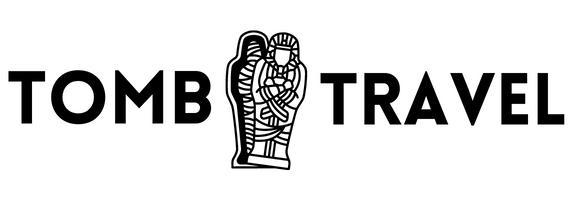Tomb of the Unknown Soldier- A Guide to Arlington National Cemetery’s Tomb of the Unknown Soldier
Purchases made through links earn us a small commission, at no extra cost to you.
The Tomb of the Unknown Soldier in Arlington National Cemetery is one of the most important and emblematic monuments in the United States. It stands as a symbolic grave for soldiers whose remains have been lost or unidentified and serves as a site for national mourning and remembrance.
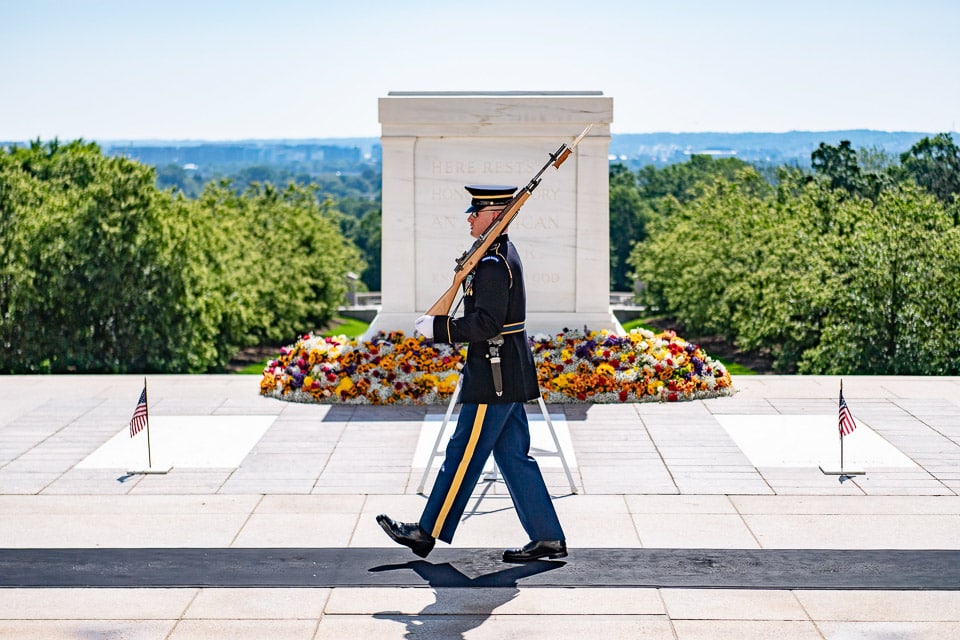
In This Post
About Tomb of the Unknown Soldier and Why it Was Created
Throughout the history of warfare, countless soldiers have died who were unable to be identified because of severe damage to their bodies, lack of personal identification, poor record keeping, and a rush to bury the bodies.
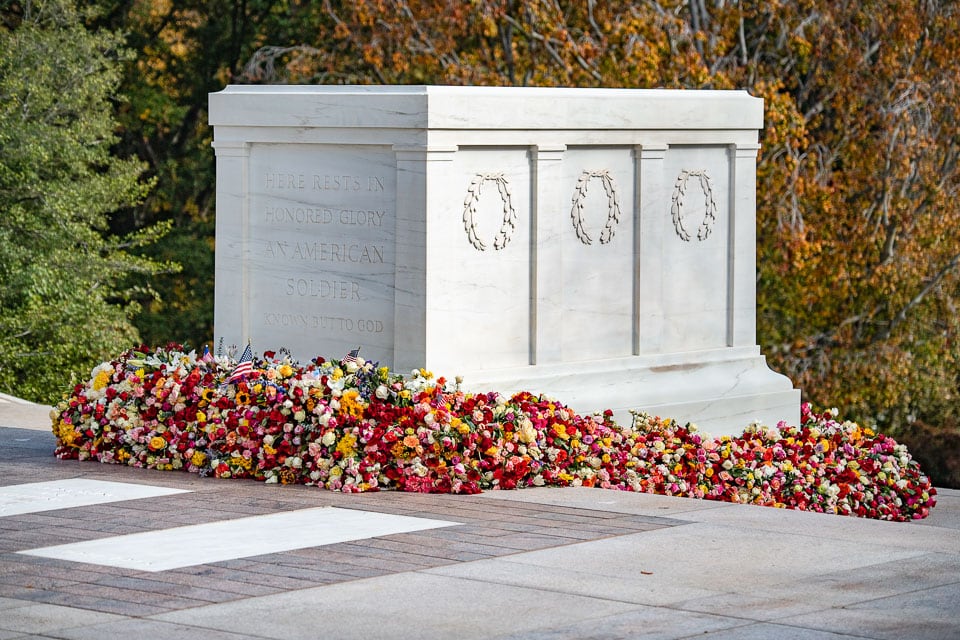
Prior to the U.S. Civil War and the establishment of national cemeteries, unidentified remains were often buried in mass graves, which was obviously distressing for family members who couldn’t grieve at a proper memorial. The creation of national cemeteries was an attempt to give all service members a proper burial, but this in itself did not help with the identification of remains. It’s estimated that almost half of the Civil War casualties were not identified.
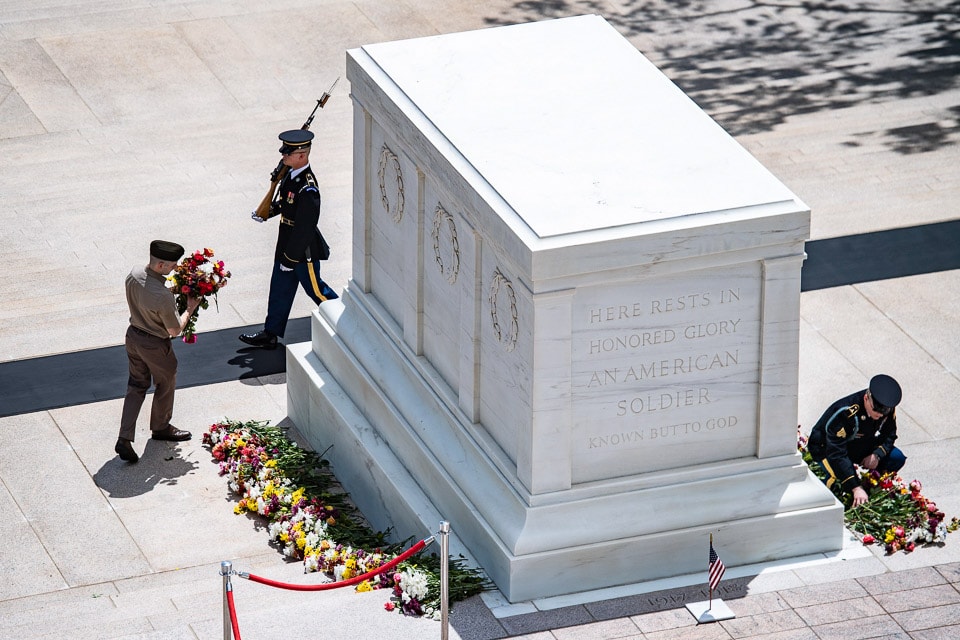
After World War I, the Tomb of the Unknown Soldier was created to represent all service members whose bodies could not be identified, and perhaps ease some of the grief of families whose loved ones’ remains were not returned to them.
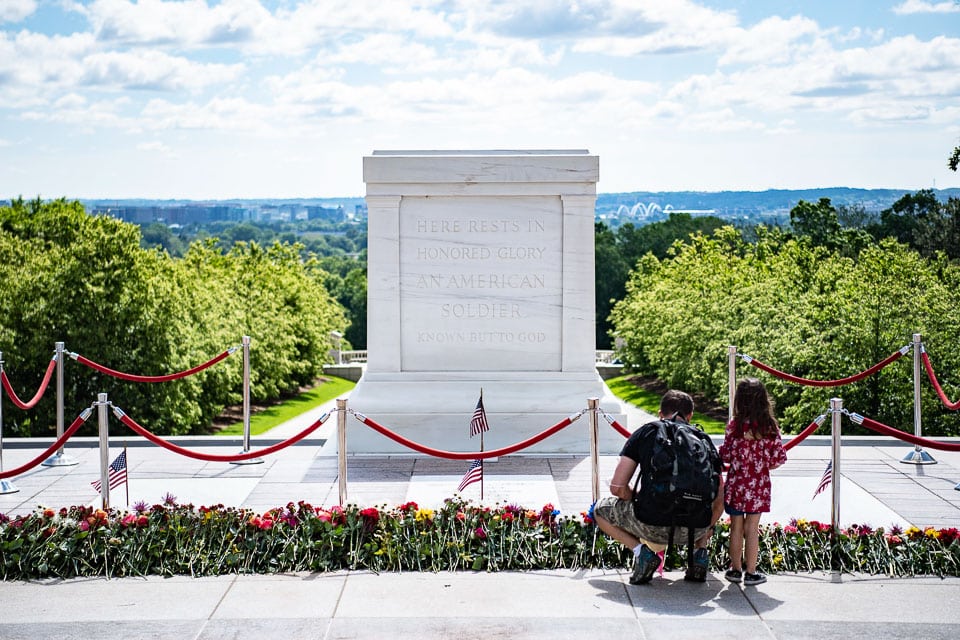
Arlington’s Tomb of the Unknown Soldier not only provides comfort for families, but is a place for all citizens to pay their respects and reflect on military service. The Tomb of the Unknown Soldier is a focal point of memorial services during which it’s tradition to lay a wreath at the base of the monument in honor of the sacrifices of service members.
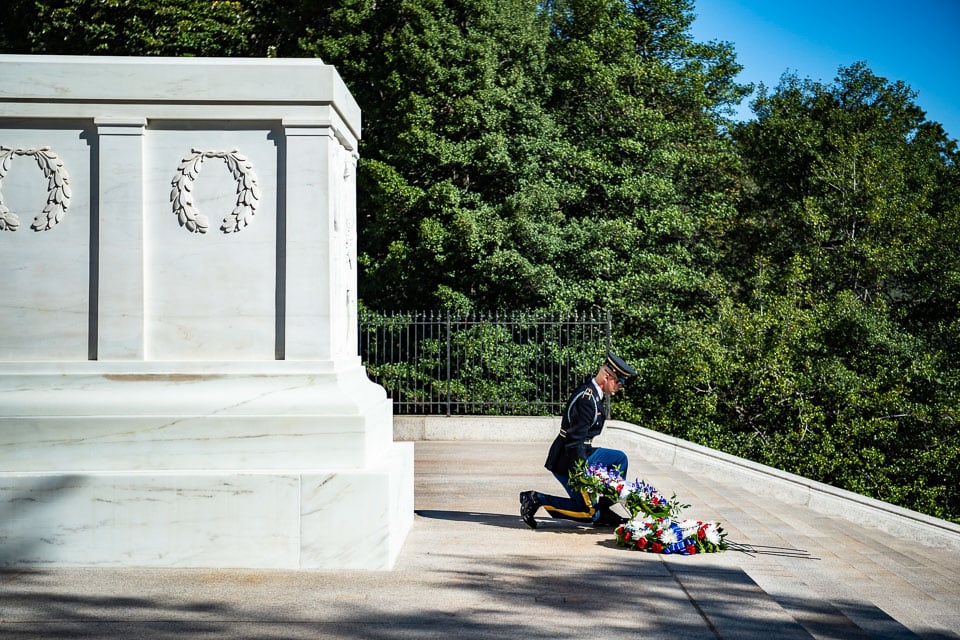
History of the Tomb of the Unknown Soldier in Arlington National Cemetery
The Tomb of the Unknown Soldier was constructed in 1921 as the final resting place for an unidentified U.S. service member from World War I.
The tomb’s construction followed legislation put forth by New York Congressman and World War I veteran Hamilton Fish Jr. He proposed that the body of an unknown American soldier be brought home and laid to rest in a special tomb at Arlington National Cemetery.
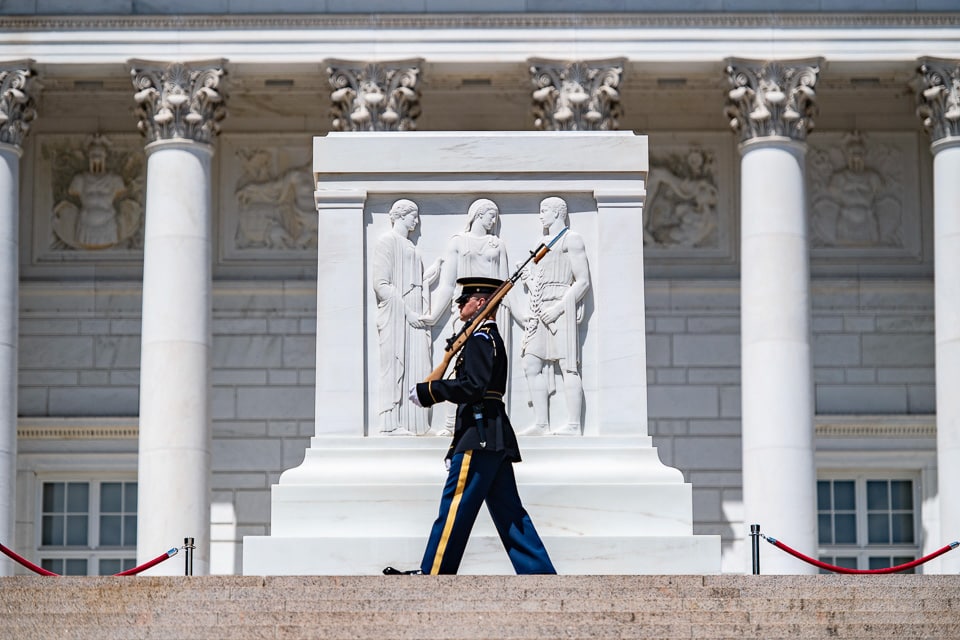
On November 11, 1921, the WWI Unknown was interred in the tomb following a state funeral ceremony at the Memorial Amphitheater. At the time, the tomb was a plain marble slab.
In 1928, the War Department held a design competition to remodel the Tomb of the Unknown Soldier into a bigger structure. The winning design featured a tree-lined avenue and wide staircase approaching a large, but simply decorated sarcophagus. This new design was completed in 1932.
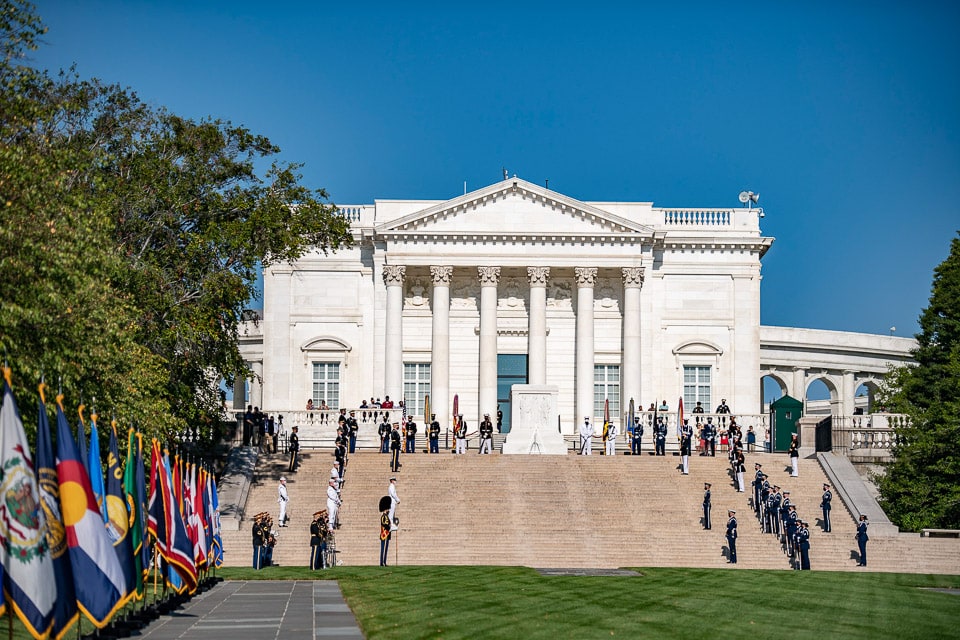
After World War II, Americans wanted an Unknown from that war to be honored as well. However, with the advent of the Korean War, this was delayed until 1956 when President Eisenhower approved crypts for a WWII Unknown and a Korean War Unknown to be added to the tomb.
During the Vietnam War, Arlington National Cemetery added another crypt to the tomb in anticipation of honoring an Unknown from that war.
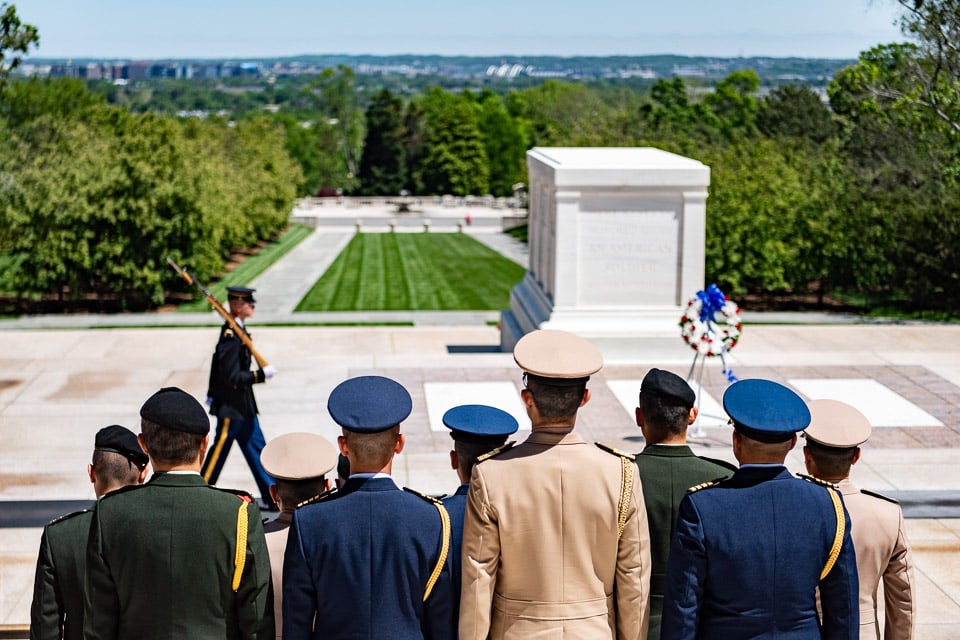
Who is in The Tomb of the Unknown Soldier and How Were They Chosen?
Inside the Tomb of the Unknown Soldier are currently the remains of three unknown soldiers- one from World War I, one from World War II, and one from the Korean War. There previously was an Unknown from the Vietnam War interred in the tomb, but he was later identified and returned to his family, as they wished. The crypt for the Vietnam War Unknown remains vacant.
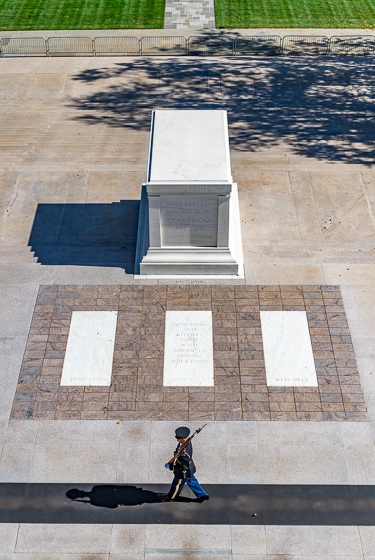
The process to decide who was buried in the Tomb of the Unknown Soldier was done by random selection. During a ceremony, a group of caskets was presented to a military member who then selected one to be sent to the Tomb of the Unknown Soldier.
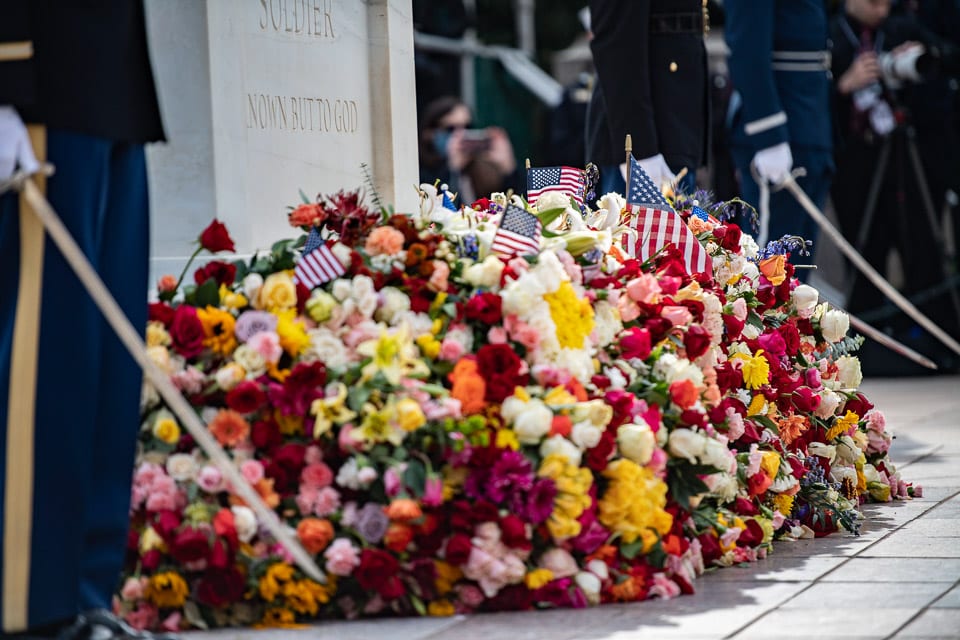
Selecting the WWI Unknown
When it came to choosing the WWI Unknown, four unidentified bodies were exhumed from different American military cemeteries in France. Their caskets were sent to the city hall in what is now called Chalons-en-Champagne, where Sgt. Edward Younger then placed a spray of white roses on the casket he was selecting for the Tomb of the Unknown.
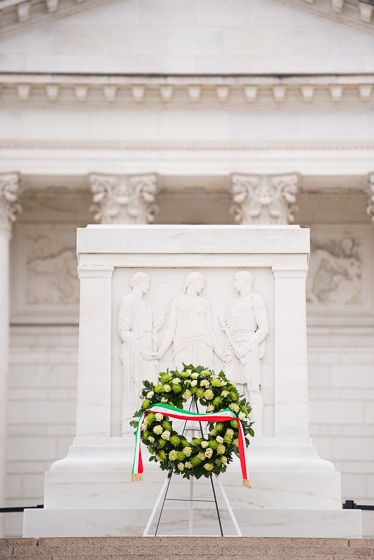
Selecting the WWII Unknown
Choosing the WWII Unknown was a little more complicated since the war was fought on four continents and the Unknown needed to represent soldiers from all theaters of the war. To ensure fair representation, Unknowns were exhumed from cemeteries in the Trans-Atlantic Theater and the Pacific Theater of World War II.
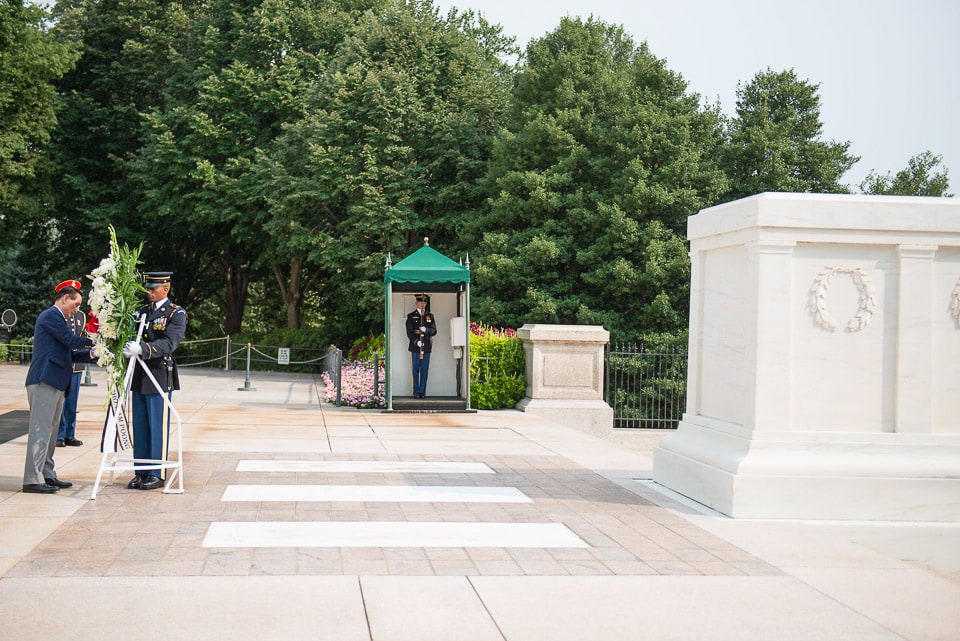
The Army exhumed 13 bodies from military cemeteries in North Africa and Europe and sent them to the Epinal American Cemetery and Memorial in France. Here Major General Edward O’Neill placed a red and white wreath on the casket of the Unknown he was selecting to represent the Trans-Atlantic theater of WWII. The chosen casket was then shipped to the United States on USS Blandy.
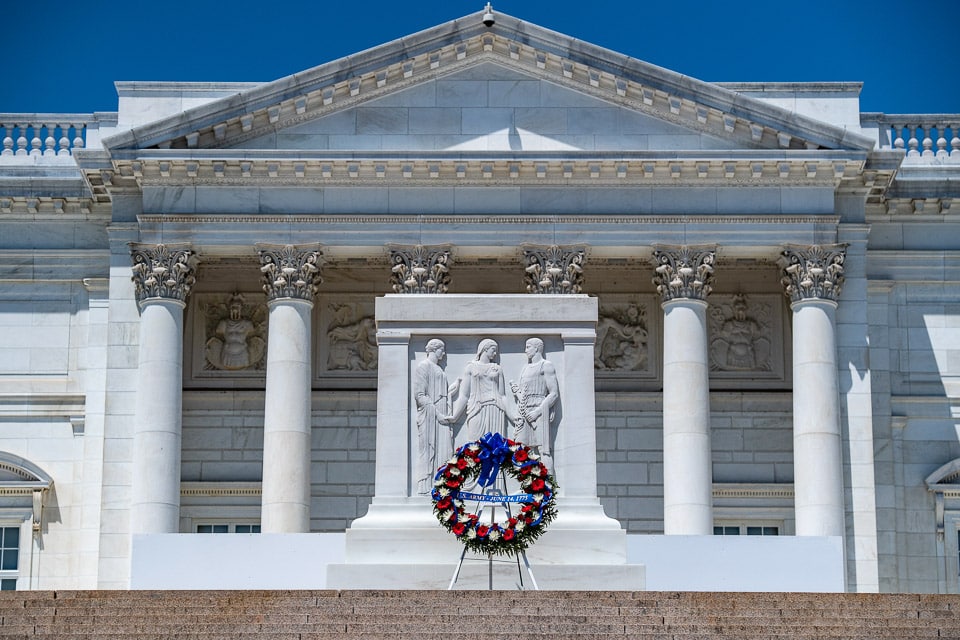
The Army exhumed five bodies from cemeteries in the Philippines and Hawaii and sent their caskets to Hickam Air Force Base. Colonel Glenn Eagleston then randomly selected a casket to represent the Unknowns from the Pacific Theater. The casket was sent to the United States on USS Boston.
The two ships later met up with the USS Canberra off the coast of Virginia. After the caskets were placed on board Canberra, William Charette selected the WWII Unknown to be sent to Arlington and the remaining Unknown was buried at sea.
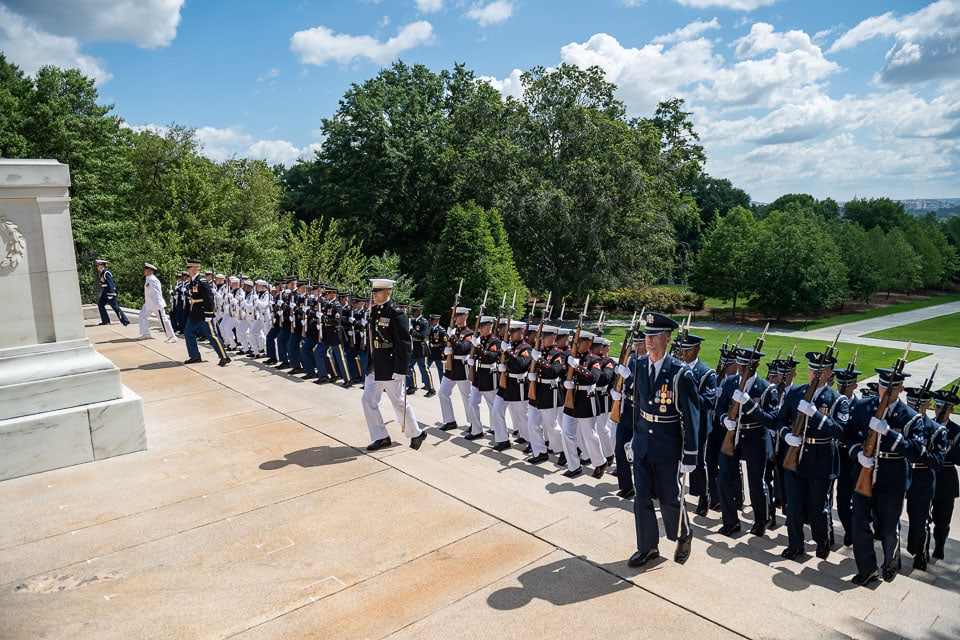
Selecting the Korean War Unknown
The Korean War Unknown was selected at Hickam Air Force Base at the same time as the Pacific Theater WWII Unknown.
Four unidentified soldiers from the Korean War were exhumed from the National Memorial Cemetery of the Pacific in Hawaii and brought to Hickam Air Force Base with the WWII Unknowns. Here Army Master Sergeant Ned Lyle chose a casket to represent the Korean War Unknown.
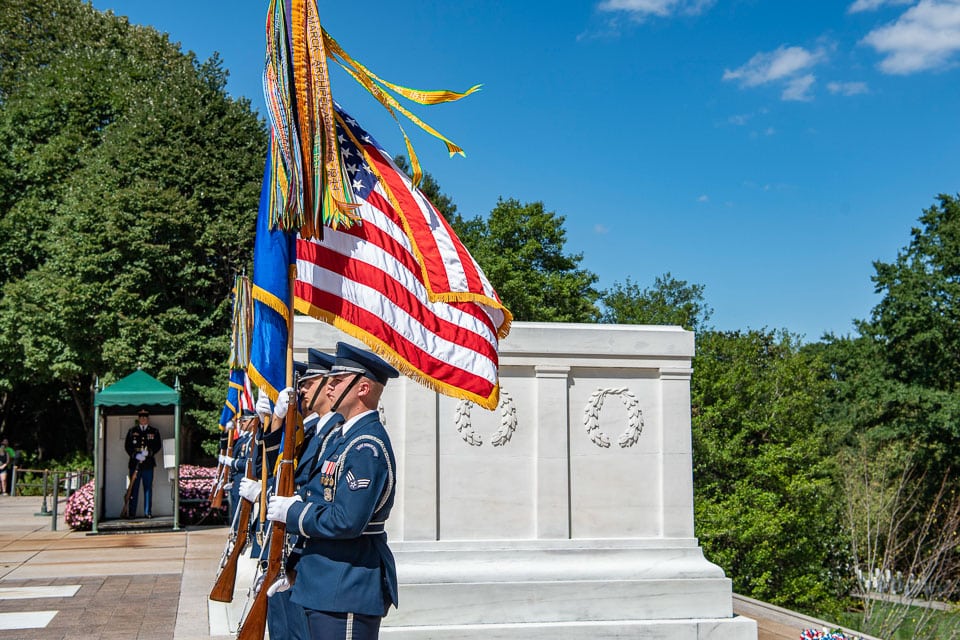
Selecting the Vietnam War Unknown
Advances in technology meant that there weren’t as many unidentified bodies from the Vietnam War. By May 1984, there was only one set of American remains that were unable to be identified.
These remains were designated as the Vietnam War Unknown during a ceremony at Pearl Harbor, Hawaii. The body was interred in Arlington’s Tomb of the Unknown Soldier on Memorial Day in 1984.
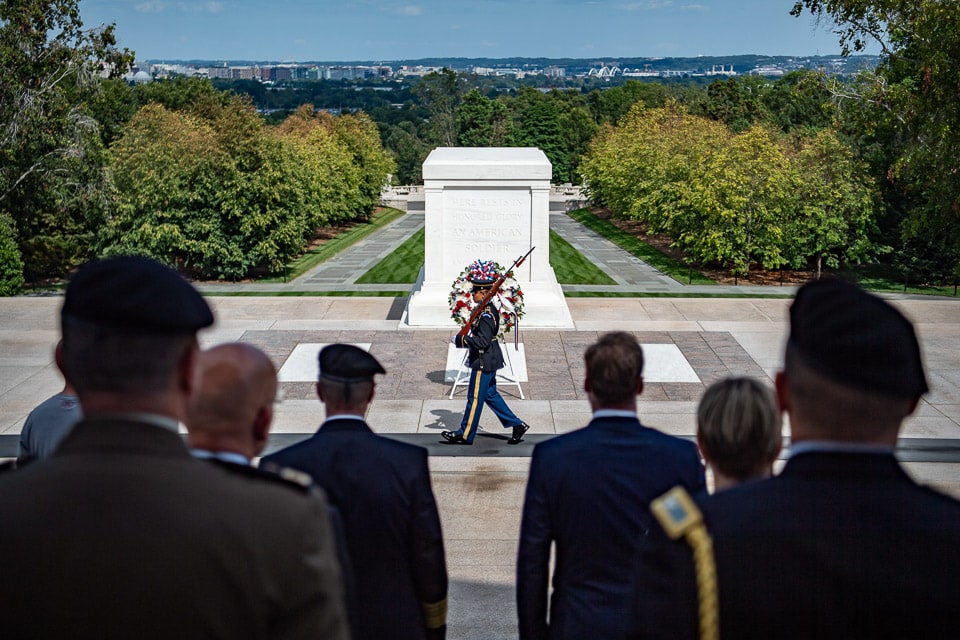
After 14 years in the Tomb of the Unknown Soldier, DNA testing identified the Vietnam Unknown as Air Force 1st Lt. Michael Joseph Blassie. Upon his family’s request, Blassie was disinterred from the tomb and buried at Jefferson Barracks National Cemetery.
Design of the Tomb of the Unknown Soldier
The Tomb of the Unknown Soldier in Arlington National Cemetery is a white marble sarcophagus that stands prominently in front of the Memorial Amphitheater.
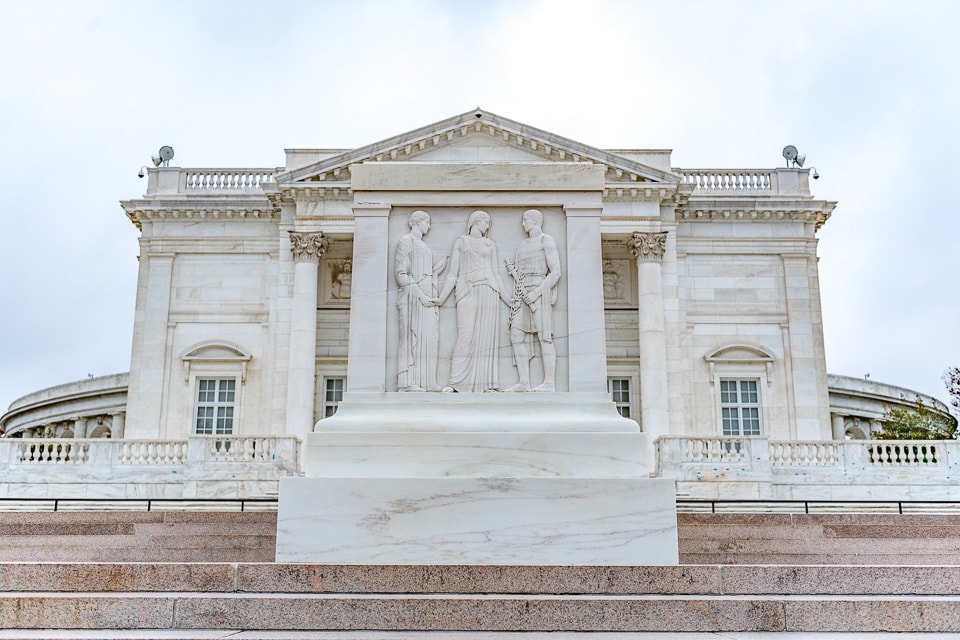
The tomb was created by architect Lorimer Rich and sculptor Thomas Hudson Jones, both who served in World War I. Like the Memorial Amphitheater, it was built in neoclassical style, a type of design that was influenced by Greek and Roman architecture.
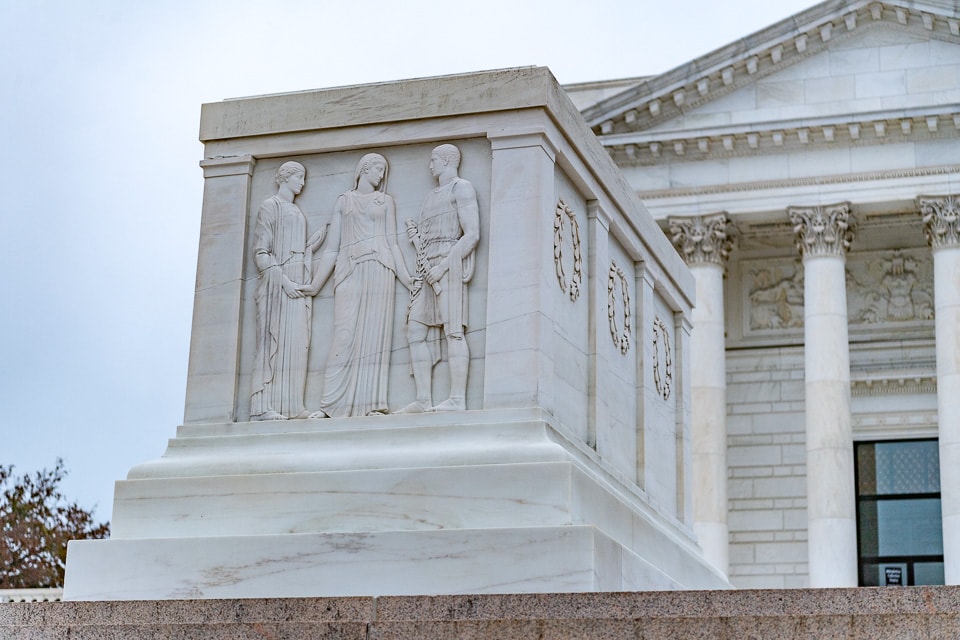
Each side of the sarcophagus is adorned with either sculptures or an inscription. On the front (facing east) are three carved figures representing Peace, Victory, and Valor.
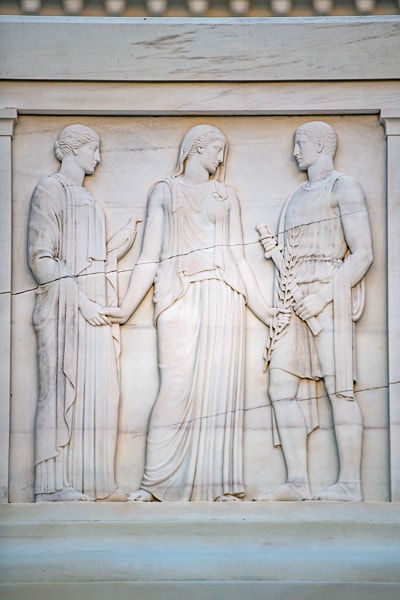
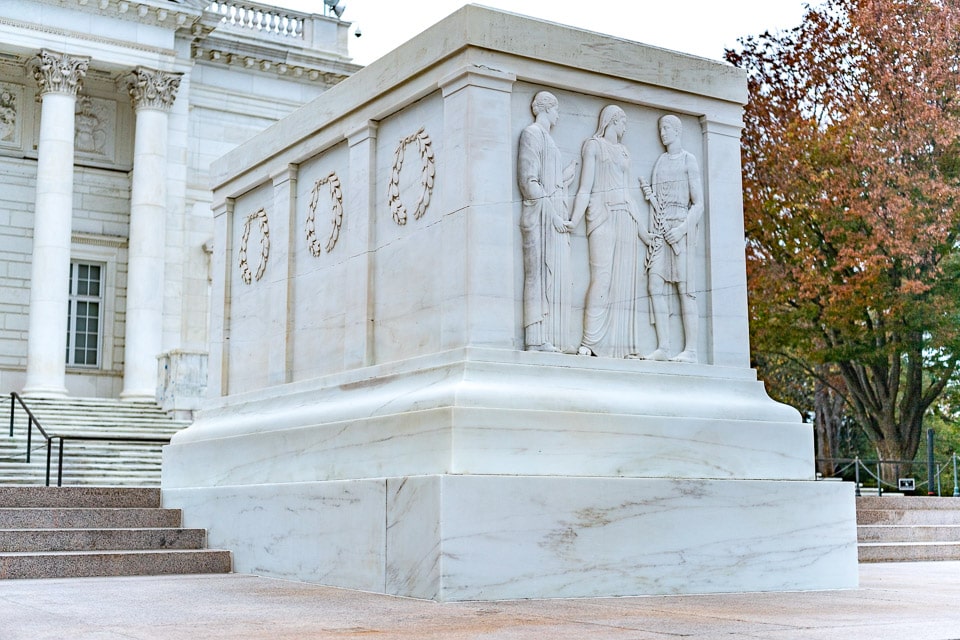
The back of the tomb displays the inscription, “Here rests in honored glory an American soldier known but to God.” The north and south sides of the sarcophagus are each decorated with three wreaths.
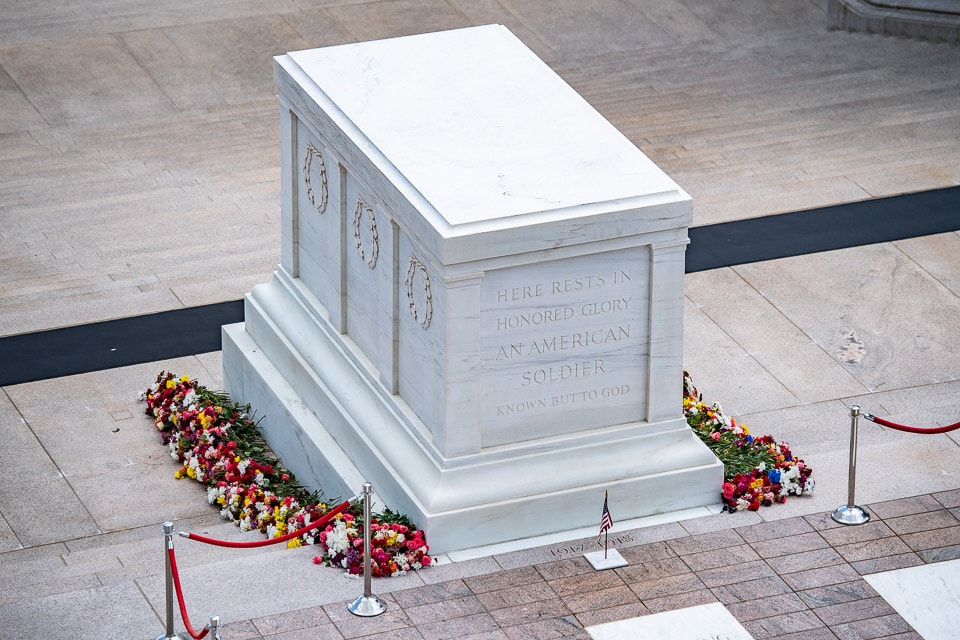
Flush with the ground in front of the sarcophagus’ west panel are crypts for the Korean War, Vietnam War, and World War II. The marble markers are inscribed with the dates of the United States’ involvement in each war. The Vietnam crypt has a further inscription that says, “Honoring and Keeping Faith with America’s Missing Servicemen” because it was rededicated in 1999 to honor soldiers that are missing from the Vietnam War.
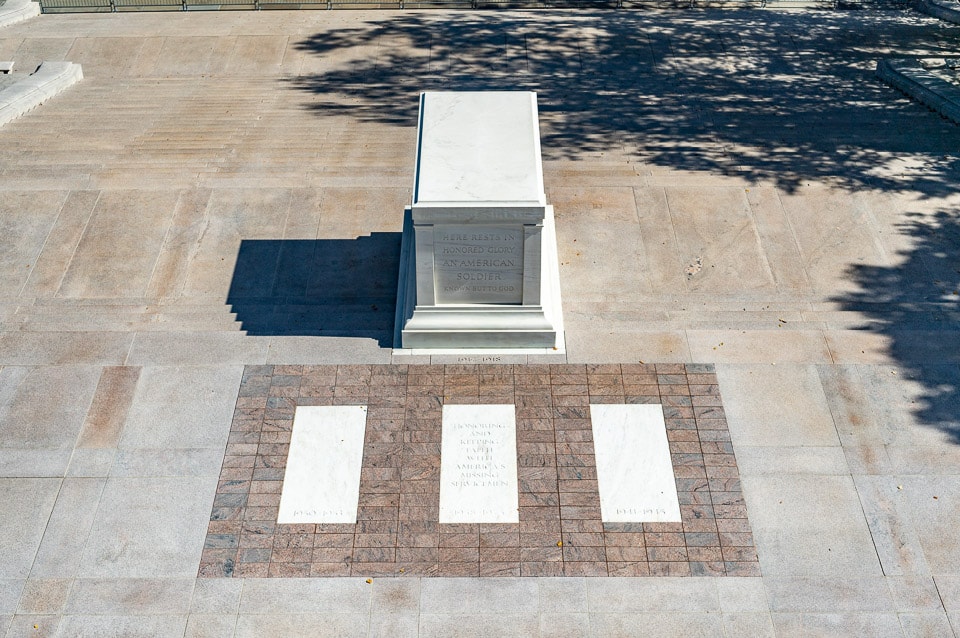
One final thing to notice at the Tomb of the Unknown Soldier is the names of Jones and Rich- the sculptor and architect- engraved on the steps of the memorial.
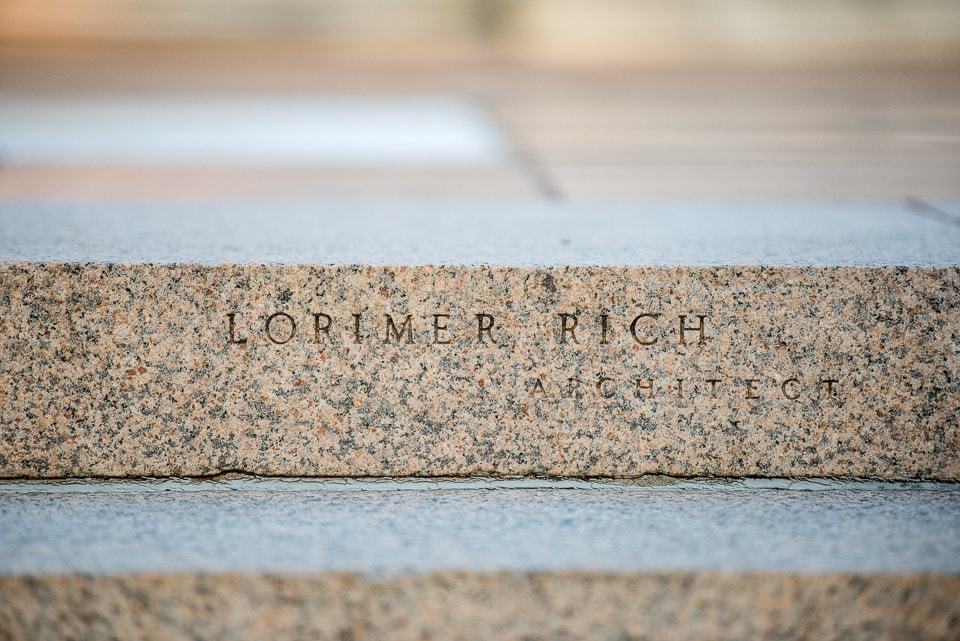
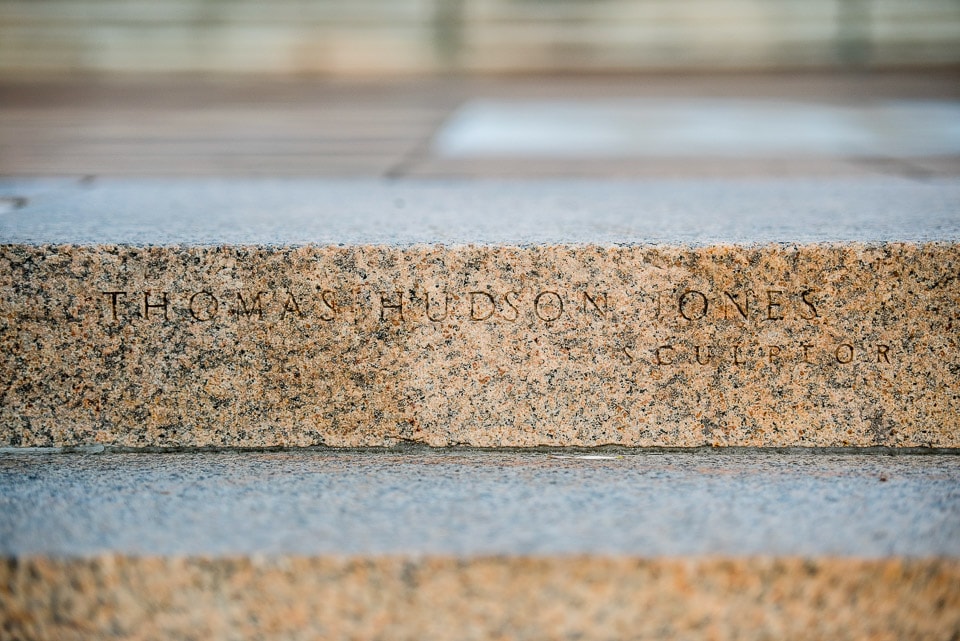
Guarding the Tomb of the Unknown Soldier- Who Guards the Tomb of the Unknown Soldier and Why
The Tomb of the Unknown Soldier is guarded to prevent visitors from climbing or stepping on the tomb.
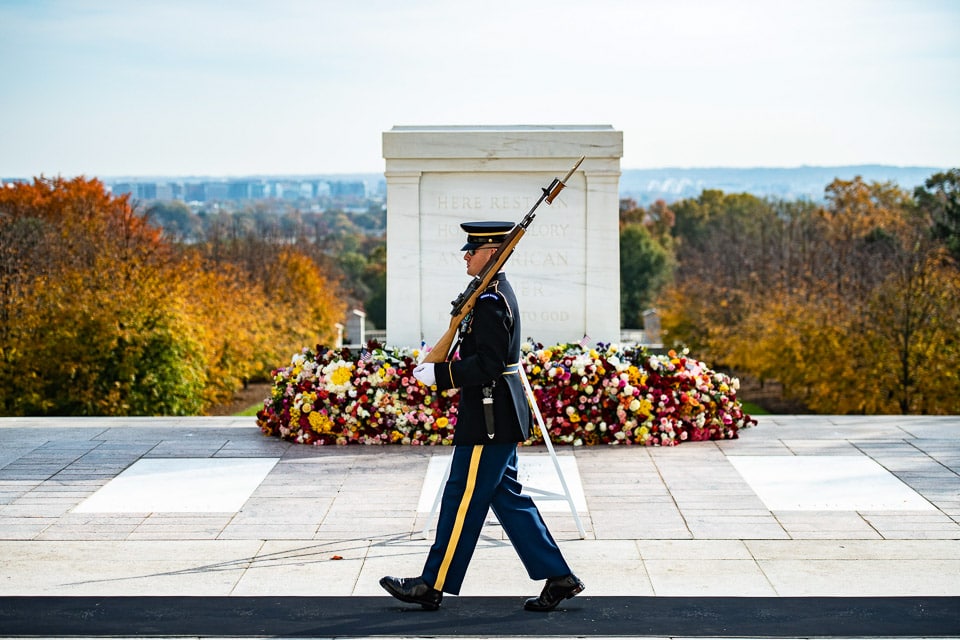
Unfortunately, the original tomb had to be fenced off because of disrespectful behavior. In 1925 the fence was replaced with a civilian guard, who was later replaced by a military guard in 1926.
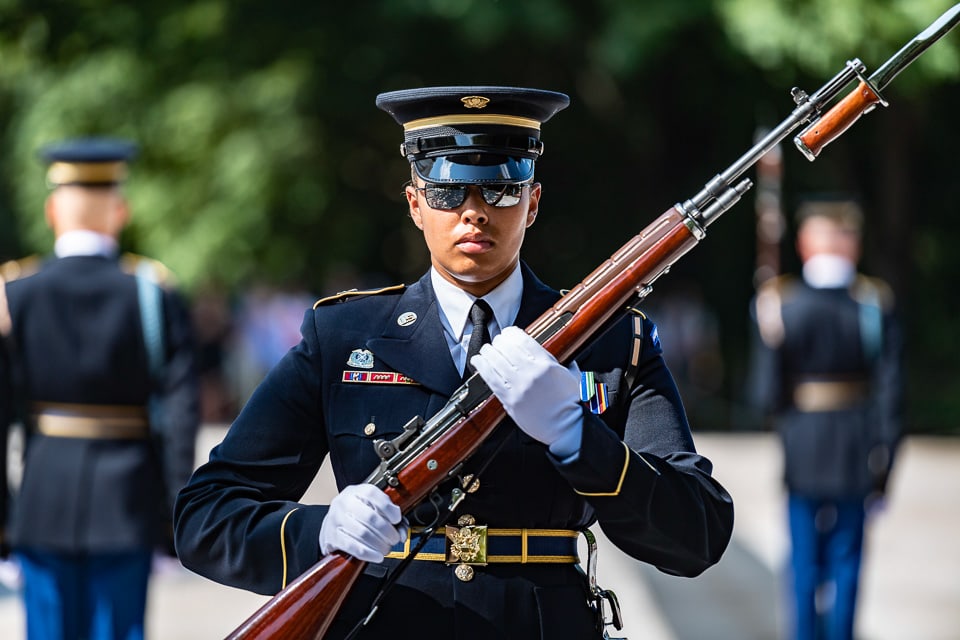
Soldiers from nearby Fort Myer were the first ones assigned as guards for the Tomb of the Unknown Soldier. They were on duty during daylight hours, but in 1937 guards at the Tomb of the Unknown Soldier became a permanent presence, standing watch 24/7 rain or shine.
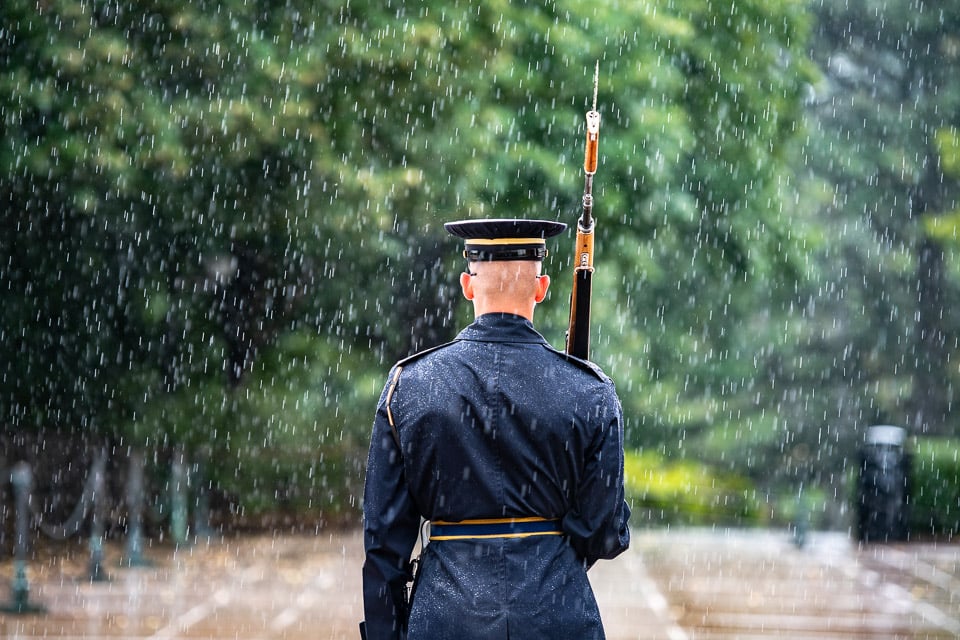
In 1948, the 3rd U.S. Infantry Regiment, known as “The Old Guard”, was appointed as the Army’s official ceremonial unit and began guarding the Tomb of the Unknown Soldier.
Soldiers who become guards for the Tomb of the Unknown Soldier have undergone a strict selection and training process. They are in top physical condition, have a perfect military record, and are able to recite seven pages of Arlington National Cemetery history verbatim. Tomb of the Unknown Soldier guards also have to pass several tests and learn the guard-change ceremony and other routines.
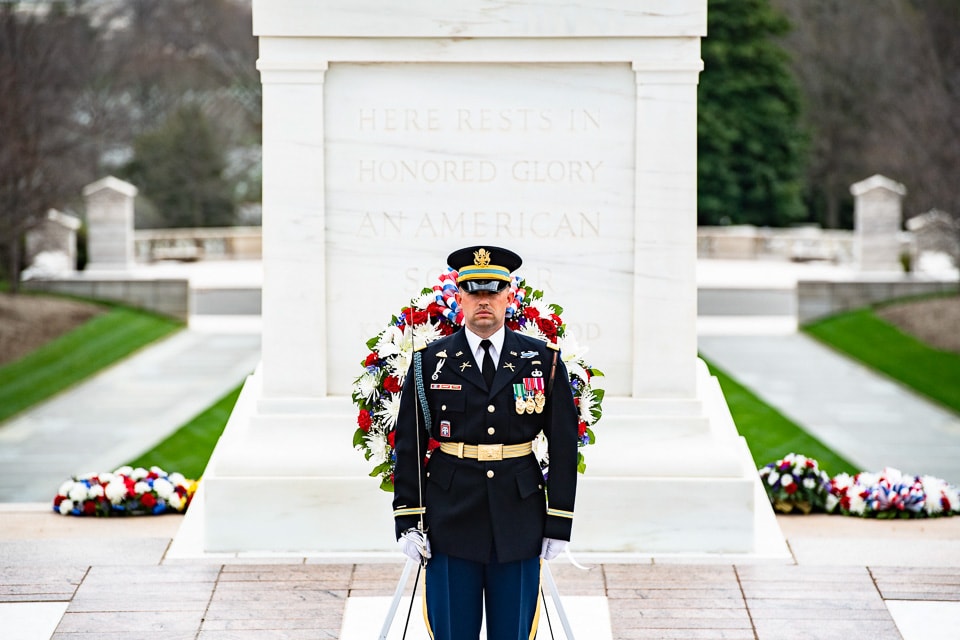
Almost everything the Tomb Guards do while on duty has symbolic meaning. Their routine involves marching 21 steps down the black mat behind the tomb, turning to face east for 21 seconds, turning to face north for 21 seconds, then marching 21 steps down the mat. The number 21 symbolizes the 21 gun salute, the highest military honor one can earn.
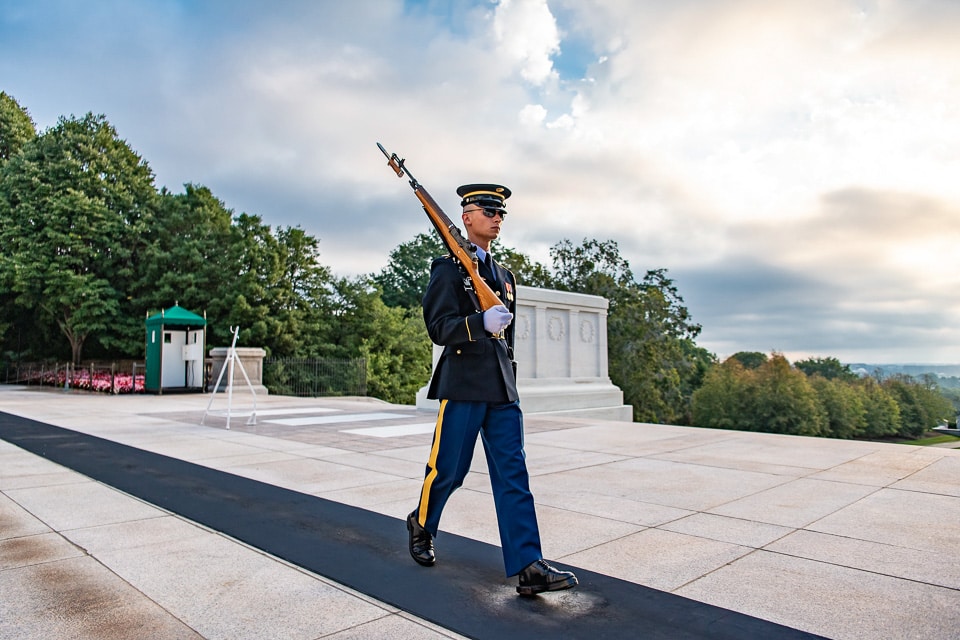
After walking the mat, the guard does a “shoulder-arms” movement to place the rifle they carry on the shoulder closest to the visitors. This signifies that the guard stands between the tomb and any possible threat.
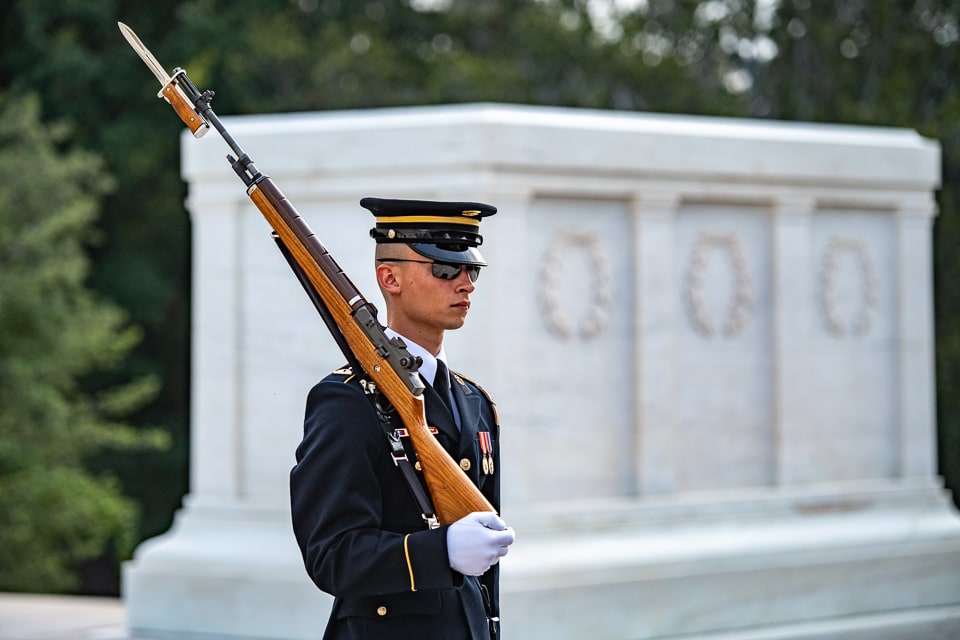
Changing of the Guard at Arlington National Cemetery
The Changing of the Guard at Arlington National Cemetery happens every hour on the hour from October through March and every 30 minutes from April through September.
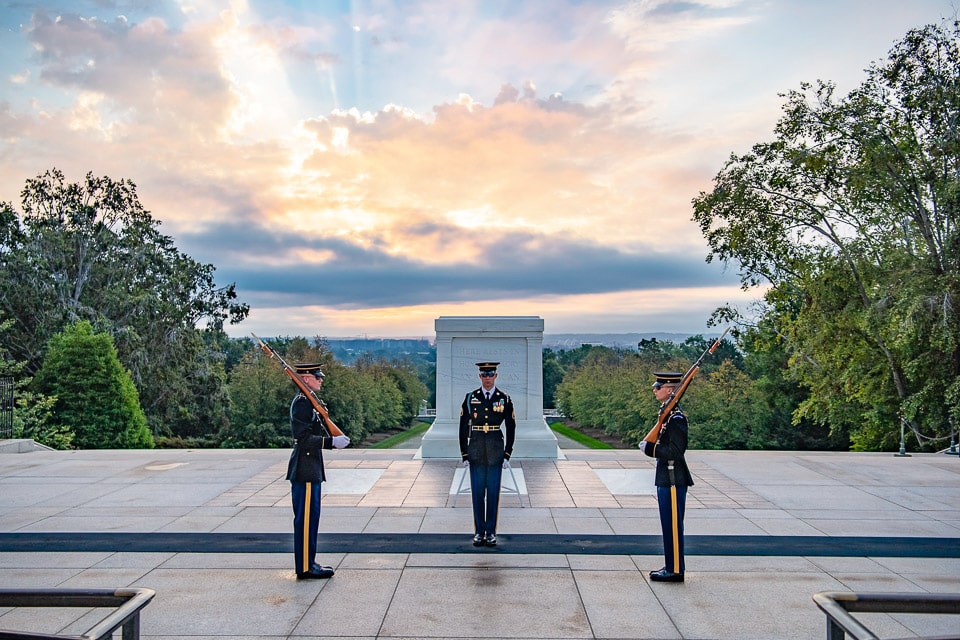
During the Changing of the Guard at the Tomb of the Unknown Soldier, the relief commander conducts a white-glove inspection of the new guard’s rifle before they both meet the retiring guard in front of the tomb.
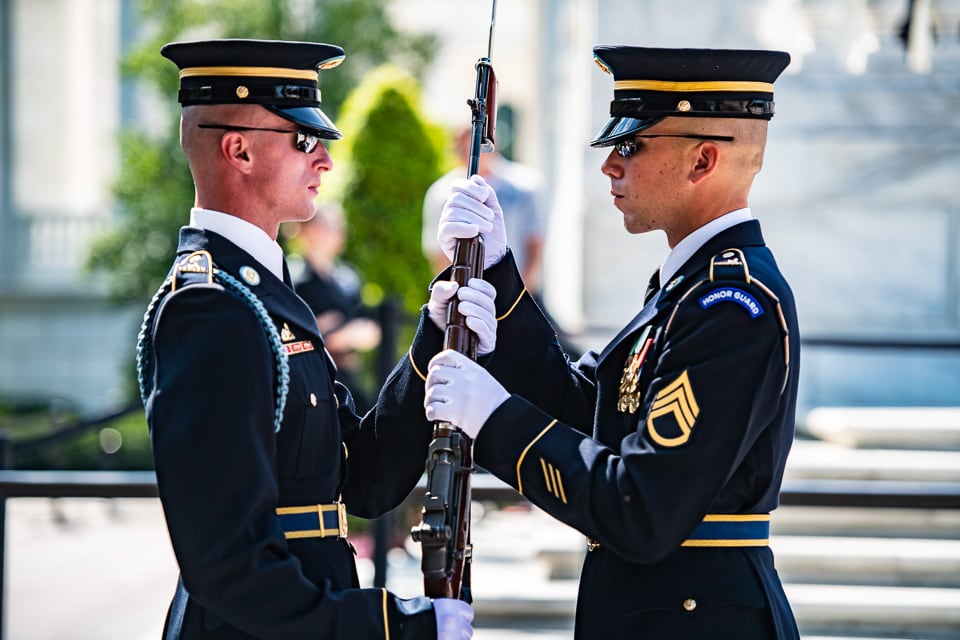
At the tomb, all three salute the Unknown Soldiers then the relief commander orders the retiring guard to “Pass on your orders”. After the passing and acknowledgment of orders between guards, the new guard begins walking the mat at a cadence of 90 steps per minute, repeating the 21 step routine described above.
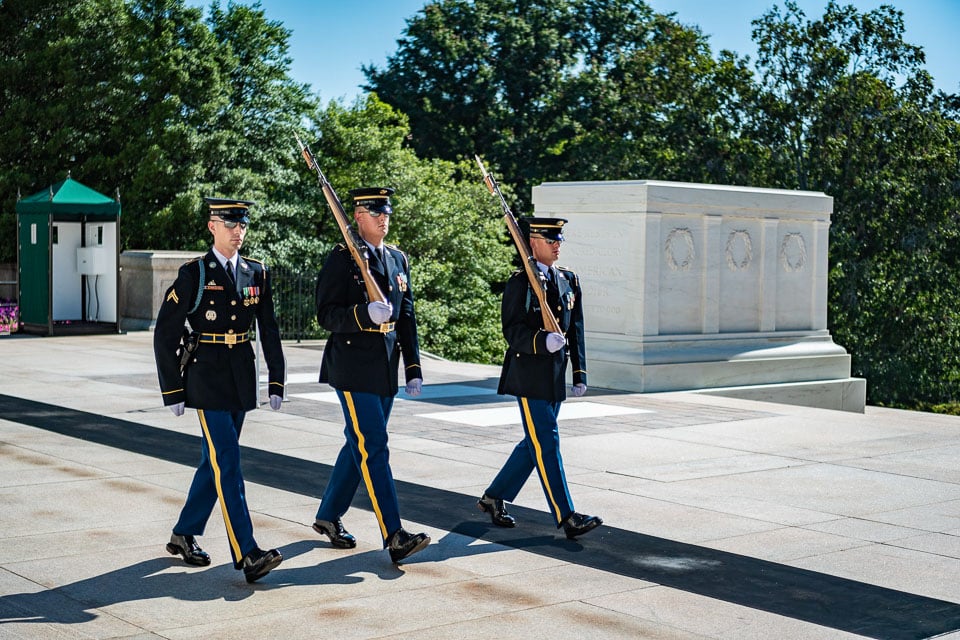
Wreath Layings at the Tomb of the Unknown Soldier
Laying a wreath at the Tomb of the Unknown Soldier is a way to honor the ultimate sacrifice paid by members of the U.S. Armed Forces.
It’s become tradition for presidents, politicians, and visiting foreign dignitaries to pay their respects by placing a wreath at the base of the tomb. Even the general public is given an opportunity to participate in a wreath-laying ceremony, but this needs to be requested and scheduled in advance.
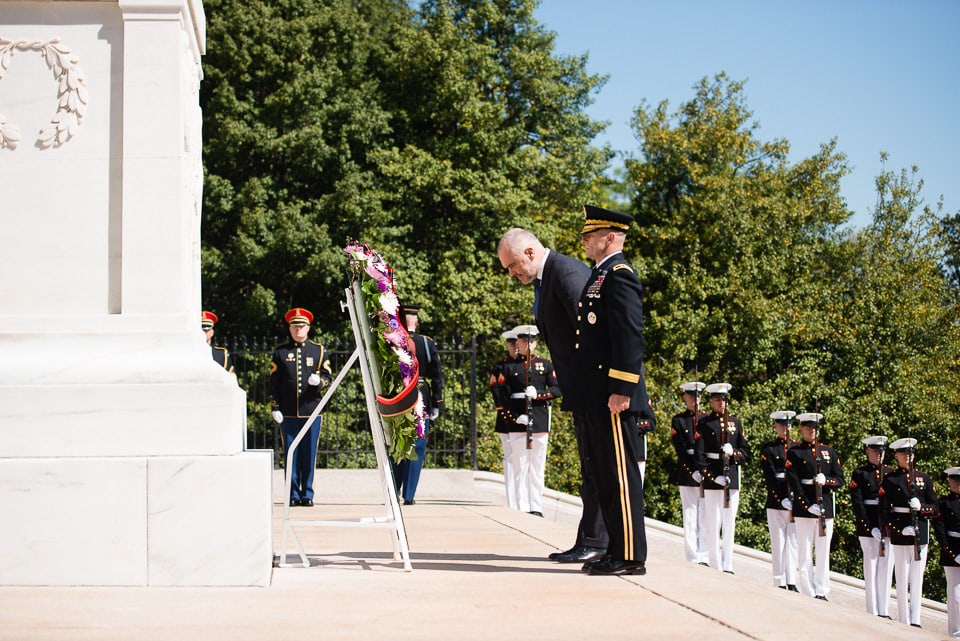
Interesting Facts About the Tomb of the Unknown Soldier in Arlington National Cemetery
Here are a few more interesting facts about the Tomb of the Unknown Soldier and its guards:
- The original tomb from 1921 was designed by Thomas Hastings, the same architect who created the Memorial Amphitheater.
- The second, and current, sarcophagus was installed before the carved designs were completed.
- At the interment ceremony for the WWI Unknown, President Harding placed the Medal of Honor on the casket, followed by several foreign dignitaries who presented their nations’ highest awards.
- Tomb Guards must be a certain height to get the job. Men have to be between 5’10” and 6’4”. Women have to be between 5’8” and 6’2” inches.
- During training, Tomb Guards learn the grave locations of nearly 300 veterans in the cemetery.
- After honorably serving for nine months at the Tomb of the Unknown Soldier, guards are eligible to upgrade their Tomb Guard Identification Badge for a permanent silver badge which may be worn for the rest of their military career. Since the late 1950s, over 600 Tomb Guards have earned this silver badge.
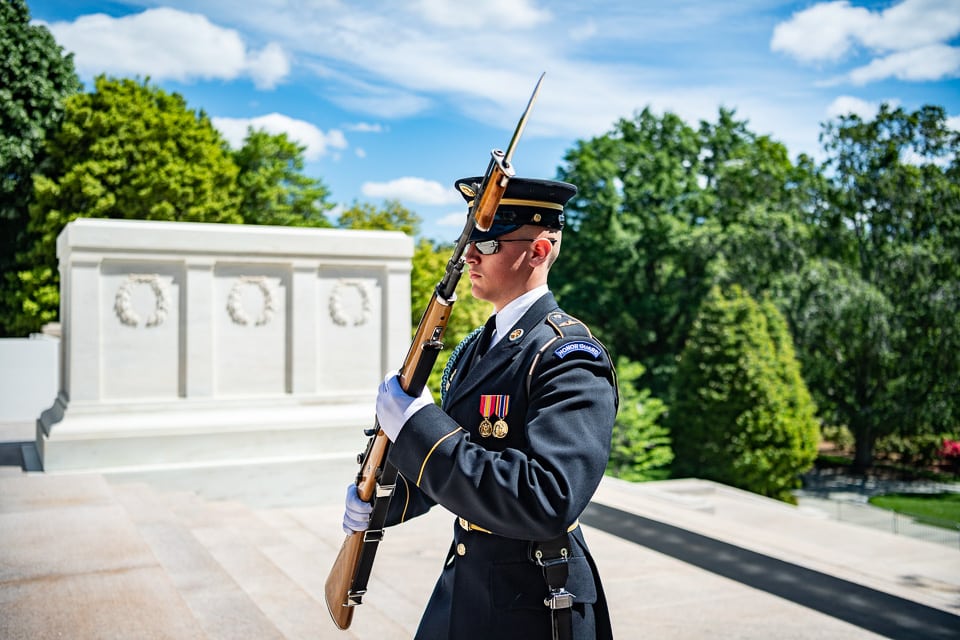
Final Thoughts
The Tomb of the Unknown Soldier is one of the most high profile burials in Arlington National Cemetery and it has been visited by millions of people from around the world.
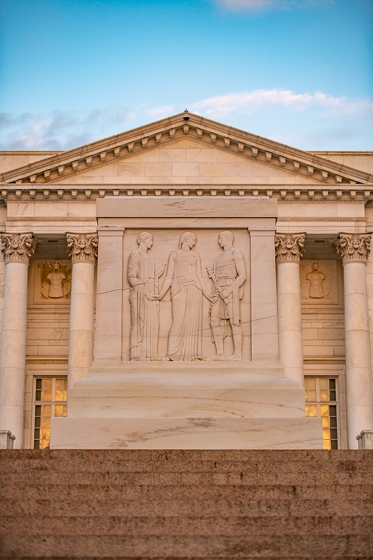
No matter your reasons for visiting the Tomb of the Unknown Soldier, be it to mourn a loved one, honor military service, or experience its historic significance, the memorial is sure to make a lasting impact. The Changing of the Guard ceremony is a unique experience as well that should not be missed when you visit Arlington National Cemetery.
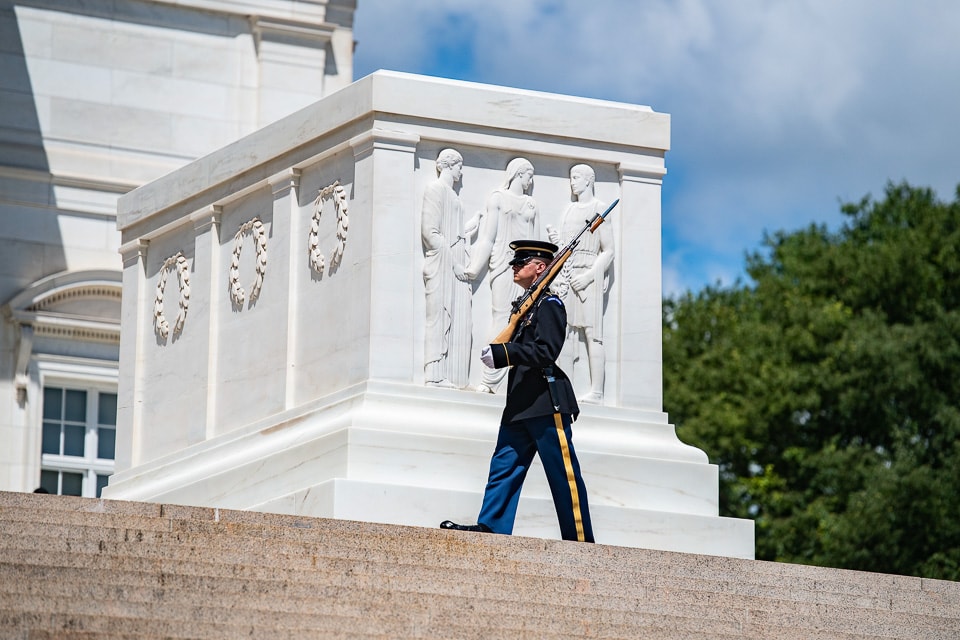
Practical Information for Visiting the Tomb of the Unknown Soldier
Location: The Tomb of the Unknown Soldier is located in Arlington National Cemetery in Arlington, Virginia. The tomb is on display in front of the Memorial Amphitheater.
Hours: The tomb can be visited during cemetery opening hours from 8:00 am to 5:00 pm daily. Confirm current hours here.
Admission Fees: None
Tours: The cemetery’s hop-on hop-off tram tour makes a stop at the Tomb of the Unknown Soldier. You can buy tickets online here.
Accommodations
If you’re planning to visit the Tomb of the Unknown Soldier and need accommodations, here is a list of hotels in the Washington D.C. Metropolitan Area. Please consider booking your accommodations through the included link. It costs nothing extra and helps support this website.
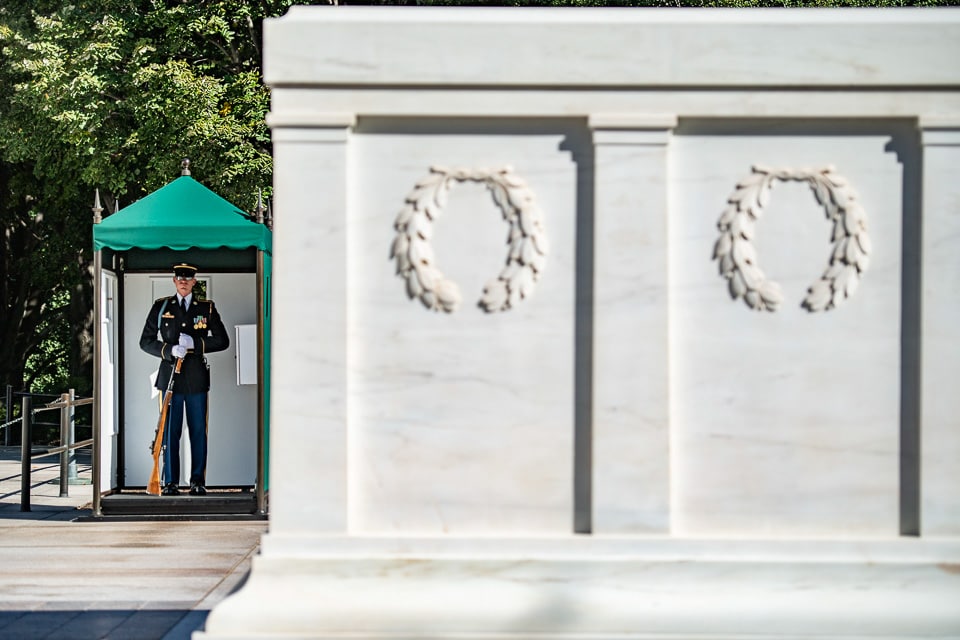
Read More About Arlington National Cemetery
More Burial Places in the United States
- Abraham Lincoln’s Tomb- Guide to Lincoln Tomb State Historic Site
- Ulysses S. Grant’s Tomb- Guide to General Grant National Memorial
- Mount Auburn Cemetery- The First Rural Cemetery in the United States
- Charleston Cemeteries- Discover Historic Cemeteries in Charleston
- Magnolia Cemetery- Charleston’s Oldest Public Cemetery
